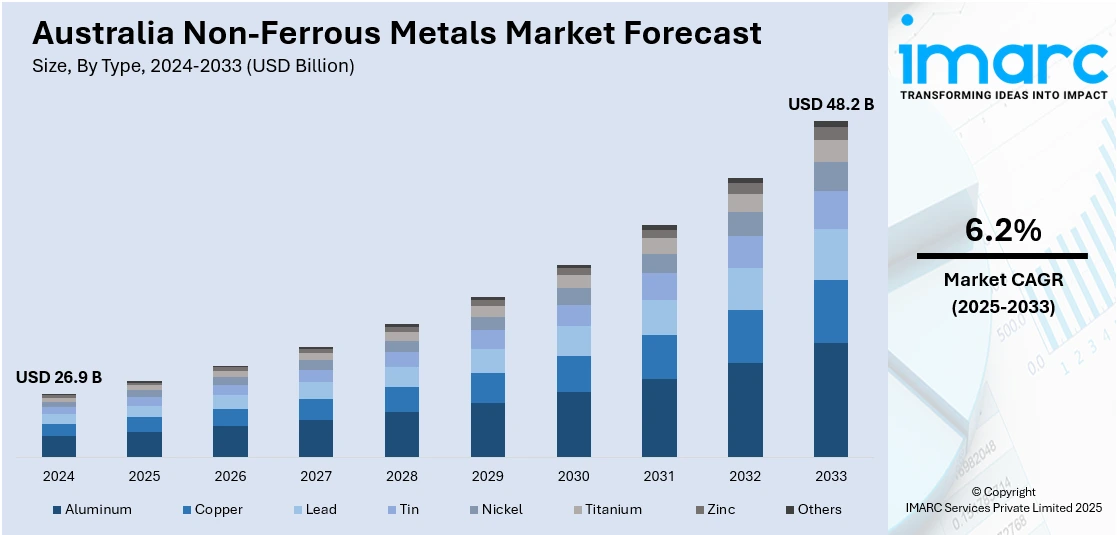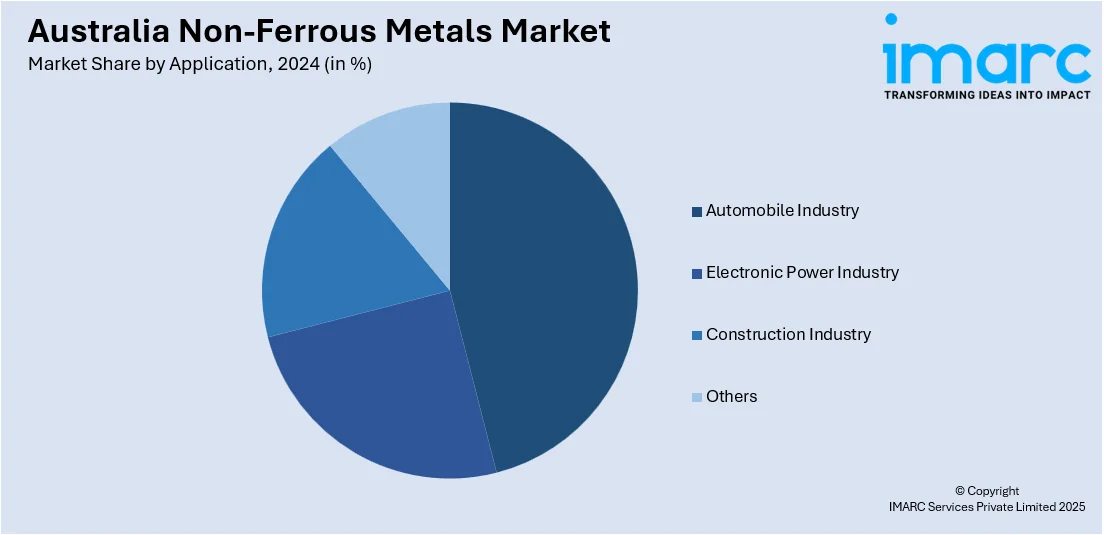
Australia Non-Ferrous Metals Market Size, Share, Trends and Forecast by Type, Application, and Region, 2025-2033
Australia Non-Ferrous Metals Market Size & Growth:
The Australia non-ferrous metals market size reached USD 26.9 Billion in 2024. Looking forward, IMARC Group expects the market to reach USD 48.2 Billion by 2033, exhibiting a growth rate (CAGR) of 6.2% during 2025-2033. Increasing innovations in the electric vehicle (EV) and renewable energy industries is impelling the market growth. This trend, along with the heightened focus on construction and infrastructure development efforts, is positively influencing the market. Moreover, advancements in metal recycling are expanding the Australia non-ferrous metals market share.
|
Report Attribute
|
Key Statistics
|
|---|---|
|
Base Year
|
2024 |
|
Forecast Years
|
2025-2033
|
|
Historical Years
|
2019-2024
|
| Market Size in 2024 | USD 26.9 Billion |
| Market Forecast in 2033 | USD 48.2 Billion |
| Market Growth Rate 2025-2033 | 6.2% |
Australia Non-Ferrous Metals Market Trends:
Increasing Demand from Construction and Infrastructure Sectors
The consumption of non-ferrous metals in Australia is rising, driven by the heightened focus on construction and infrastructure development efforts. As urban developments are created, requirements for aluminum, copper, and zinc as raw materials are rising higher. Non-ferrous metals are also strongly desired because of their low density, resistance to corrosion, and ductility properties, rendering them best suited to utilize within buildings, bridges, highways, and other supporting infrastructure development endeavors. As residential and commercial construction continues to increase substantially, the demand for such materials is rising consistently. Additionally, Australia’s infrastructure renewal projects aimed at enhancing transport, utilities, and telecommunications are impelling the market growth. Non-ferrous metals are also applied to electrical cabling, pipes, and roof structures, all of which are vital to contemporary urban development. The IMARC Group predicts that the Australia construction market size will reach USD 588 Billion by 2033.

To get more information on this market, Request Sample
Expanding Electric Vehicle (EV) and Renewable Energy Industries
Increase in innovations in the electric vehicle (EV) and renewable energy industries is contributing to the Australia non-ferrous metals market growth. The most recent figures from the Federal Chamber of Automotive Industries (FCAI) and Electric Vehicle Council (EVC) indicate that 8,385 battery electric vehicles were sold in Australia in March 2025, a proportion of 7.5% of the total new car market, which consisted of 111,617 cars sold in the month. With Australia shifting towards cleaner forms of energy and sustainable modes of transport, the demand for non-ferrous metals like copper and aluminum is increasing. Non-ferrous metals are crucial to EV production because of their excellent conductivity, low weight, and strength, making them crucial in components such as electric motors, batteries, and wiring. The growing use of solar power, wind power, and other clean technologies is further catalyzing the demand for non-ferrous metals since they find widespread use in energy storage devices, inverters, and transmission lines. The government's intent to pursue net-zero emissions and the use of renewable energy sources to produce energy is creating the need for these metals.
Technological Advancements in Metal Recycling
Technological advancements in metal recycling are significantly driving the market. Innovations in recycling technologies are making it more efficient and cost-effective to recover valuable metals, such as aluminum, copper, and lead, from scrap materials. This is reducing the dependence on primary metal extraction, lowering production costs, and minimizing environmental impact. Australia’s recycling industry is continuously improving its processes, adopting more sophisticated methods like hydrometallurgical and pyrometallurgical techniques to recover and refine non-ferrous metals. The country’s focus on reducing its carbon footprint and improving sustainability practices in the industrial sectors is improving the growth of recycling operations. As recycled non-ferrous metals become more widely available, they are increasingly integrated into production processes, helping to meet the rising demand while also addressing environmental concerns. Moreover, these developments in recycling technologies are shaping the market in Australia. In 2024, Australia-based aluminum extrusions manufacturer Capral Ltd. tested the recycled-content billet provided by Rio Tinto at its Boyne Smelter in Australia. Trial billets were made from 50-100 metric tons of Capral's postproduction aluminum scrap at the company's Bremer Park extrusion plant.
Australia non-ferrous metals Market Segmentation:
IMARC Group provides an analysis of the key trends in each segment of the market, along with forecasts at the country and regional levels for 2025-2033. Our report has categorized the market based on type and application.
Type Insights:
- Aluminum
- Copper
- Lead
- Tin
- Nickel
- Titanium
- Zinc
- Others
The report has provided a detailed breakup and analysis of the market based on the type. This includes aluminum, copper, lead, tin, nickel, titanium, zinc, and others.
Application Insights:

- Automobile Industry
- Electronic Power Industry
- Construction Industry
- Others
A detailed breakup and analysis of the market based on the application have also been provided in the report. This includes automobile industry, electronic power industry, construction industry, and others.
Regional Insights:
- Australia Capital Territory & New South Wales
- Victoria & Tasmania
- Queensland
- Northern Territory & Southern Australia
- Western Australia
The report has also provided a comprehensive analysis of all the major regional markets, which include Australia Capital Territory & New South Wales, Victoria & Tasmania, Queensland, Northern territory & Southern Australia, and Western Australia.
Competitive Landscape:
The market research report has also provided a comprehensive analysis of the competitive landscape. Competitive analysis such as market structure, key player positioning, top winning strategies, competitive dashboard, and company evaluation quadrant has been covered in the report. Also, detailed profiles of all major companies have been provided.
Australia Non-Ferrous Metals Market Report Coverage:
| Report Features | Details |
|---|---|
| Base Year of the Analysis | 2024 |
| Historical Period | 2019-2024 |
| Forecast Period | 2025-2033 |
| Units | Billion USD |
| Scope of the Report | Exploration of Historical Trends and Market Outlook, Industry Catalysts and Challenges, Segment-Wise Historical and Future Market Assessment:
|
| Types Covered | Aluminum, Copper, Lead, Tin, Nickel, Titanium, Zinc, Others |
| Applications Covered | Automobile Industry, Electronic Power Industry, Construction Industry, Others |
| Regions Covered | Australia Capital Territory & New South Wales, Victoria & Tasmania, Queensland, Northern territory & Southern Australia, Western Australia |
| Customization Scope | 10% Free Customization |
| Post-Sale Analyst Support | 10-12 Weeks |
| Delivery Format | PDF and Excel through Email (We can also provide the editable version of the report in PPT/Word format on special request) |
Key Questions Answered in This Report:
- How has the Australia non-ferrous metals market performed so far and how will it perform in the coming years?
- What is the breakup of the Australia non-ferrous metals market on the basis of type?
- What is the breakup of the Australia non-ferrous metals market on the basis of application?
- What is the breakup of the Australia non-ferrous metals market on the basis of region?
- What are the various stages in the value chain of the Australia non-ferrous metals market?
- What are the key driving factors and challenges in the Australia non-ferrous metals market?
- What is the structure of the Australia non-ferrous metals market and who are the key players?
- What is the degree of competition in the Australia non-ferrous metals market?
Key Benefits for Stakeholders:
- IMARC’s industry report offers a comprehensive quantitative analysis of various market segments, historical and current market trends, market forecasts, and dynamics of the Australia non-ferrous metals market from 2019-2033.
- The research report provides the latest information on the market drivers, challenges, and opportunities in the Australia non-ferrous metals market.
- Porter's five forces analysis assist stakeholders in assessing the impact of new entrants, competitive rivalry, supplier power, buyer power, and the threat of substitution. It helps stakeholders to analyze the level of competition within the Australia non-ferrous metals industry and its attractiveness.
- Competitive landscape allows stakeholders to understand their competitive environment and provides an insight into the current positions of key players in the market.
Need more help?
- Speak to our experienced analysts for insights on the current market scenarios.
- Include additional segments and countries to customize the report as per your requirement.
- Gain an unparalleled competitive advantage in your domain by understanding how to utilize the report and positively impacting your operations and revenue.
- For further assistance, please connect with our analysts.
 Request Customization
Request Customization
 Speak to an Analyst
Speak to an Analyst
 Request Brochure
Request Brochure
 Inquire Before Buying
Inquire Before Buying




.webp)




.webp)












